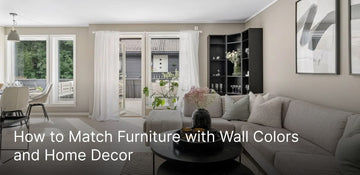
Creating a harmonious home environment involves matching furniture with wall colors and decor. This can seem tricky, but with a few guidelines, you can create a space that feels both comfortable and stylish. Here's a simple guide to help you blend these elements effectively.
Start with a Color Scheme
Choosing a color scheme is your first step. Think about the mood you want to set in your room. Soft, neutral colors like beige, gray, and whites create a calming atmosphere, while bright colors like red, blue, or green can energize a space.
-
Neutral Walls: If your walls are painted in neutral tones, you're in luck. Neutral walls can handle furniture of any color. To avoid a bland look, add colorful accessories like cushions, rugs, and artwork.
- Bold Walls: With bold wall colors, balance them with furniture in neutral or complementary shades. For example, navy walls can be paired with light gray or tan furniture.
Consider the Natural Light
The amount of natural light in your room can influence how colors look. Light can make colors appear different at various times of the day.
-
Bright Rooms: In well-lit rooms, most colors tend to look vibrant. You can choose darker furniture without the fear of making the room feel small.
- Darker Rooms: In rooms with less natural light, opt for lighter-colored furniture to make the space feel brighter and bigger.
Mix and Match Styles
Don’t be afraid to mix different styles of furniture and decor. This can add personality to your room. However, try to maintain some elements that tie the room together, like a consistent color or material.
- Traditional Meets Modern: You can mix traditional wooden furniture with modern metal accents. Keep the color palette similar to unite the styles.
Use Textures and Patterns
Textures and patterns can add depth and interest to your room. If your walls are a single color, consider furniture with interesting textures or patterns.
-
Textured Furniture: A suede couch or a leather armchair can add a lot of interest to a simple room.
- Patterned Decor: Patterned cushions, rugs, or curtains can break the monotony and bring vibrancy to a neutral setting.
Plan Your Space
Before you buy new furniture, measure your space. Make sure there’s enough room to walk around comfortably. Plan where each piece of furniture will go. This helps in maintaining a balanced look without overcrowding the room.
Experiment with Accent Colors
Accent colors can bring a room to life. Choose one or two accent colors that complement the primary colors in your room. Use these for smaller items like vases, lamps, or wall art.
-
Subtle Accents: A calm room can benefit from subtle accents like pale blue or soft yellow.
- Vibrant Accents: In a room with neutral walls and furniture, vibrant accents like magenta or bright yellow can make a statement.
Reflect Your Personality
Your home should reflect your personality. Choose colors and styles that make you feel happy and comfortable. Whether it’s a bold artwork or a unique piece of furniture, make sure it’s something that truly represents you.
Bring in Greenery
Adding plants to your decor can bring freshness and life to any room. Plants not only add color and texture but also improve air quality. Choose plants that thrive in your home's light conditions and complement your decor style.
Summary
Matching furniture with wall colors and home decor doesn't have to be complicated. Start with a basic color scheme, consider the lighting, mix different styles, add textures and patterns, plan your space, use accents to enhance the visual appeal, and don’t forget to include personal touches and greenery. By following these tips, you can create a space that feels both cohesive and uniquely yours. Remember, the most important thing is that your space makes you feel at home.






